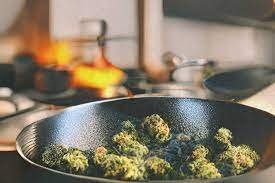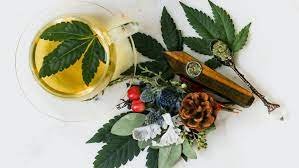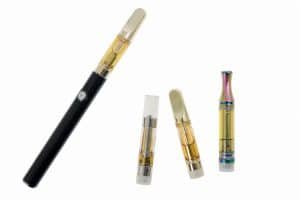Cooking with cannabis is not as challenging as one might think. The plant has as much culinary potential as any other ingredient. To be able to cook cannabis food, you need to know the basics of infusion and the science of cooking with weed.
Here, we will explore the science of cannabis-infused recipes so you can create flavorful dishes with therapeutic and relaxing benefits. Whether a chef or a beginner, you will benefit from our guide.
Sections
ToggleWhy Cook with Cannabis?

When we say cooking with cannabis, it raises a fair share of eyebrows as to why one would want to infuse food with cannabis.
As opposed to traditional methods of consumption, infusing food with cannabis has long-lasting effects compared to smoking or vaping. It is also a safer method of consumption because when cannabis is ingested through food, the body processes it differently, resulting in a more prolonged and often more intense experience. Additionally, cannabis-infused food is an attractive option for those seeking sustained relief from various conditions.
Another reason why someone will want to experiment with cooking with weed is because it provides a healthier alternative to smoking. Smoking cannabis has the potential respiratory risks associated with inhaling smoke. It’s also a discreet way to consume cannabis, making it ideal for those who prefer privacy or live in shared spaces.
As an ingredient, cannabis is a versatile substance. When cooking with cannabis, you can create a menu ranging from savory dishes to sweet treats. With endless culinary creativity, you can use cannabis creatively – a morning smoothie to elevate your mood or create a gourmet dinner.
Understanding Cannabis Infusion

To understand how to infuse cannabis in food, we have to look into what constitutes cannabis. The active compounds in cannabis plants include cannabinoids, terpenes, THC, and THCA. When we infuse cannabis into food, we make these extracts and other beneficial compounds from the plant material available for consumption in a culinary form.
The core scientific process behind cannabis infusion is the activation of cannabinoids, primarily THC and CBD. In the raw form, these compounds are acids tetrahydrocannabinolic acid (THCA) and Cannabidiolic acid (CBDA). These compounds need to convert into active forms through decarboxylation to have any effect. This is a crucial step in cooking with weed, as it ensures that the desired effects are achieved when consuming cannabis-infused food.
Decarboxylation occurs naturally when cannabis is heated, breaking a carbon bond to convert acids into THC and CBD. This is the reason why smoking or vaping cannabis products produces immediate effects. This is an essential concept for anyone cooking with cannabis to understand how to activate the cannabinoids before infusion.
Choosing the Right Cannabis for Cooking
There are several forms of cannabis that you can explore for culinary use to achieve the desired results. When cooking with weed, you have several options to choose from:
- Flower: Dried cannabis buds are known flowers and are the most commonly used for cooking with cannabis. It allows for greater control over strain selection and potency, as you can pick the cannabis buds depending on their curing methods.
- Concentrates: A more processed cannabis extract, concentrates such as shatter or hash are potent extracts. You can use concentrates for cooking with THC or CBD-focused recipes.
- Oils: Pre-made cannabis oil for cooking offers convenience and consistency in dosing.
You have to be careful with the selection of the strain for your cannabis recipes. This selection should be based on desired effects and flavor profiles. Indica strains of the plant are often associated with relaxation. It is more suitable for evening meals, while sativa strains can energize daytime dishes. For a balance effect, you can consider hybrid strains. Whichever strain you choose, always pay attention to the THC and CBD content, as this will impact the potency of your weed-infused food.
Preparing Your Cannabis for Cooking
You cannot use the cannabis extracts in raw form; before you can start cooking with cannabis, you need to prepare it properly.
Here’s a step-by-step guide to decarboxylation for activating the cannabis extracts:
- Preheat your oven to 240°F (115°C).
- Break up your cannabis into small pieces and spread it evenly on a baking sheet.
- Bake for 30-40 minutes, stirring occasionally.
- Let it cool before using it in your recipes.
You can also create cannabis oil or cannabis-infused butter (cannabutter) from decarboxylated cannabis. Follow these steps to make cannabis-infused oil:
- Combine decarboxylated cannabis with your chosen base oil. Coconut and olive oil make excellent bases for cannabis infusion. Mix both in a 1:1 ratio.
- Heat the mixture in a double boiler for 2-3 hours, stirring occasionally.
- Strain the oil through a cheesecloth to remove plant material.
- Store in an airtight container in a cool, dark place.
You can use the infused oil/butter as a base for various cannabis recipes or as a substitute for regular oil in your favorite dishes.
Different Methods of Cooking with Cannabis

There are several methods for cooking with weed, and each other own advantages:
1. Baking: This is the ideal method for creating cannabis-infused recipes like brownies, cookies, and cakes. The low, controlled heat of baking helps preserve cannabinoids and terpenes. This precise temperature control may preserve the cannabis profile but may result in a more robust raw cannabis flavor.
2. Sautéing: Great for incorporating cannabis into savory dishes, you can use cannabis-infused oil or butter as your cooking fat for sauteing. However, it is challenging to cook as this method requires acute temperature monitoring, as in oil/butter form, cannabinoids can quickly overheat.
3. Infusing beverages: Add tinctures or infused syrups to create cannabis-infused teas, smoothies, or cocktails. However, cannabis-infused drinks have a very short shelf life.
4. No-heat methods: For raw food enthusiasts, cannabis can be added to dishes like salad dressings or pesto without heating. It can result in stronger effects but might not be a fit method for everyone.
Dosage Guidelines for Cooking with Cannabis
When cooking with cannabis, you have to be careful with dosage. The potency of your cannabis-infused food depends on several factors, including the strength of your starting material and the serving size of your dish.
Follow these steps to calculate THC/CBD levels per serving:
- Determine the total THC/CBD content of the cannabis used. Read the product label to learn the THC/CBD percentage.
- Factor in loss of potency during the cooking process. Typically, 10-20% of THC and CBD is lost during the cooking process.
- Divide the total by the number of servings in your recipe.
For example, if you use 1 gram of cannabis with 15% THC (150mg) to make 10 servings, each serving would contain approximately 13.5-15mg of THC, accounting for some loss during cooking.
Generally, start with a low dose when cooking with weed, especially for beginners. A typical starting dose for edibles is 2.5-5mg of THC. Also, some recipes will have a delayed effect; therefore, wait at least two hours before consuming more.
Tips for Incorporating Cannabis into Everyday Recipes
Do not go reinventing your recipes to infuse cannabis. Almost every time, you can easily incorporate cannabis into your favorite recipes. You can:
- Substituting regular oil or butter with cannabis-infused versions to add the benefits or effects of cannabis into your food.
- Add a few drops of cannabis tincture to sauces or dressings for mild effects.
- Using cannabis-infused honey or sugar in baked goods or beverages.
Different cannabis extracts have different flavors and textures. Consider this when adding cannabis to your dishes. As with any other ingredient, the distinct taste of cannabis can complement or clash with certain ingredients. Experiment with herbs and spices that pair well with cannabis, such as rosemary, thyme, or cinnamon, to create a balanced flavor profile in your cannabis-infused recipes.
Exploring Advanced Cannabis Recipes
If you are looking to elevate your cannabis cooking skills by creating more sophisticated dishes, here are some recipes more experienced cooks can explore:
- Cannabis-infused risotto with wild mushrooms: Use cannabis oil or butter as the base for the traditional risotto.
- THC-infused lobster bisque: You can add THC-infused tincture to the lobster bisque sauce to add a cannabis experience.
- CBD-infused chocolate truffles with sea salt: Try experimenting with CBD buds while baking chocolate truffles for something sweet.
- Cannabis-infused balsamic reduction for steak
These advanced cannabis recipes often involve more complex cooking techniques and flavor combinations. You must use your culinary experience and skills to incorporate cannabis and related temperature variations into the recipes.
Types of Cannabis Edibles

Your menu will never be boring if you add cannabis-infused food, as recipes extend far beyond the classic “pot brownie.”
Some of the most popular types of edibles include:
- Gummies and candies
- Chocolates and truffles
- Baked goods (cookies, cakes, pastries)
- Savory snacks (chips, popcorn)
- Beverages (teas, sodas, wines)
Each edible has its own onset time and duration of effects. Chewable products will have a delayed but prolonged effect, while candies and beverages may take effect more quickly due to sublingual absorption.
Safety and Legal Considerations
Cannabis remains a scheduled substance under federal law. Therefore, before cooking with cannabis, it’s essential to be aware of the legal status in your area. Even if cannabis is legal in your region, there may be restrictions on homemade edibles or limits on possession amounts.
Another safety concern when cooking with weed is to avoid accidental or overconsumption.
Always store your cannabis-infused food in clearly labeled, child-proof containers away from regular food items. To avoid overconsumption, always start with a low dose and wait at least two hours before consuming more. In case of adverse effects from consuming too much cannabis, stay calm, stay hydrated, and remember that the effects will pass.
Conclusion
As a potential ingredient, cooking with cannabis opens up a world of culinary possibilities. Whether you’re interested in cooking with weed for medicinal purposes or to enjoy a unique gastronomic adventure, we hope this guide will make a quick reference for cannabis cooking.




